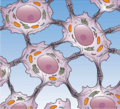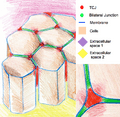Cell junction facts for kids
Cell junctions are like tiny connectors that hold cells together in our bodies. Think of them as special glue or tiny zippers that link neighboring cells. They are super important for how our tissues work, helping cells communicate and keeping things organized.
These junctions are made of long protein chains. These proteins help cells connect to each other or to other structures around them. They also help control what goes in and out of the cell's surface.
Contents
What Are Cell Junctions?
Our bodies are made of trillions of tiny building blocks called cells. These cells often need to stick together to form tissues, like your skin or muscles. Cell junctions are the special structures that make these connections possible. They are found in many different tissues, especially where cells need to be tightly linked or communicate quickly.
Main Types of Cell Junctions
In animals with backbones, like humans, there are three main types of cell junctions. Each type has a different job, helping our bodies function smoothly.
Adherens Junctions: Strong Connections
Adherens junctions are like strong anchors that hold cells tightly together. They give tissues structural support, meaning they help tissues stay strong and resist pulling or stretching. You'll find many adherens junctions in places that experience a lot of mechanical stress. For example, they are common in your skin and heart, which are always moving and stretching.
Desmosomes: Super Strong Spot Welds
Desmosomes are a type of adherens junction. Imagine them as tiny spot welds that firmly attach cells to each other. They are especially strong and help tissues like skin withstand a lot of pressure and friction without tearing apart.
Hemidesmosomes: Half-Welds to the Outside
Hemidesmosomes are similar to desmosomes, but they are "half" junctions. Instead of connecting two cells, they connect a cell to the material outside of it, called the extracellular matrix. This helps anchor cells firmly to their surroundings, which is important for tissues like your skin to stay attached to what's underneath.
Gap Junctions: Cell Communication Channels
Gap junctions are like tiny tunnels or doorways between neighboring cells. They allow small molecules and electrical signals to pass directly from one cell to another. This is super important for quick communication. For example, in your heart, gap junctions help heart muscle cells beat together in a coordinated way.
Tight Junctions: Sealing the Gaps
Tight junctions act like a waterproof seal between cells. They prevent water and other liquids from leaking between layers of cells. Think of them as the grout between tiles in a bathroom, stopping water from getting through. These junctions are very important in tissues like your intestines and kidneys, where they control what substances can pass through and prevent unwanted leaks.
Images for kids
Learn More
 In Spanish: Unión celular para niños
In Spanish: Unión celular para niños




